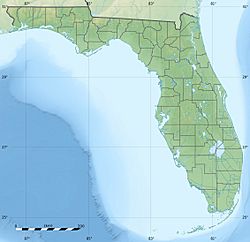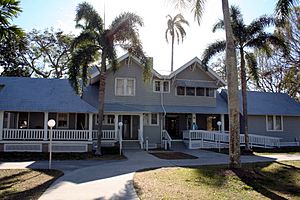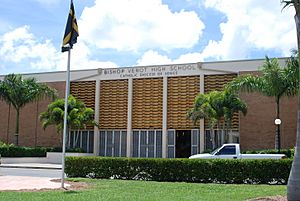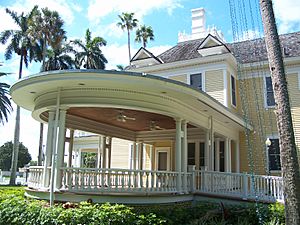Fort Myers, Florida facts for kids
Quick facts for kids
Fort Myers, Florida
|
||
|---|---|---|
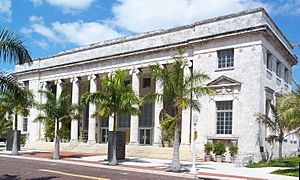
Sidney and Berne Davis Art Museum in downtown Fort Myers
|
||
|
||
| Motto(s):
"City of Palms"
|
||
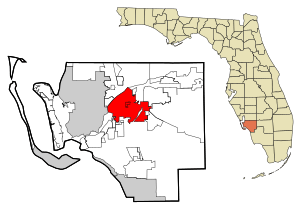
Location in Lee County, Florida
|
||
| Country | ||
| State | ||
| County | Lee | |
| Founded | March 24, 1885 | |
| Incorporated | August 12, 1885 | |
| Government | ||
| • Type | Council–Manager | |
| Area | ||
| • Total | 49.04 sq mi (127.00 km2) | |
| • Land | 39.84 sq mi (103.19 km2) | |
| • Water | 9.20 sq mi (23.81 km2) | |
| Elevation | 10 ft (3 m) | |
| Population
(2020)
|
||
| • Total | 86,395 | |
| • Estimate
(2022)
|
95,949 | |
| • Rank | 370th in country (as of 2021) | |
| • Density | 2,168.44/sq mi (837.24/km2) | |
| Time zone | UTC−5 (Eastern (EST)) | |
| • Summer (DST) | UTC−4 (EDT) | |
| ZIP Codes |
33901-33903, 33905-33908, 33912-33913, 33916-33919, 33965-33967, 33993-33994
|
|
| Area code(s) | 239 | |
| FIPS code | 12-24125 | |
| GNIS feature ID | 0282700 | |
Fort Myers is a city in Florida, United States. It is the main city of Lee County. In 2020, about 86,395 people lived there. By 2022, the population was estimated to be 95,949. This makes it one of Florida's largest cities.
Fort Myers is a popular place for tourists. Many people visit the Edison and Ford Winter Estates, which were the winter homes of famous inventors Thomas Edison and Henry Ford. The city is named after a fort built during the Seminole Wars. This fort was named after Colonel Abraham Myers.
The city has a diverse population. You can visit places like Centennial Park along the Caloosahatchee River. Other fun spots include the IMAG History & Science Center and the Calusa Nature Center and Planetarium.
Contents
History of Fort Myers
Long ago, the Calusa people lived near where Fort Myers is today. Later, different European countries, like Spain and Great Britain, had control over Florida. Finally, it became part of the United States.
The Seminole Wars and the Fort
During the Second Seminole War (1835-1842), the U.S. Army built a fort called Fort Dulaney. A hurricane destroyed it in 1841. So, the army moved up the Caloosahatchee River and built Fort Harvie. This fort was later abandoned.
In 1849, after a conflict with the Seminole people, the Army returned. In 1850, they built a new fort on the ruins of Fort Harvie. This new fort was named Fort Myers. It was named after Colonel Abraham Myers, who worked for the Army.
Fort Myers was a large and important fort. It had 57 buildings and a long dock for ships. It was used until 1858, when the Third Seminole War ended.
Fort Myers During the Civil War
During the American Civil War, Fort Myers was used by both sides. At first, people who supported the Confederates used it for trading.
In 1864, the Union Army took control of Fort Myers. They wanted to stop the Confederates from getting cattle from Florida. The fort also offered a safe place for people who supported the Union. It was also a haven for people who had escaped slavery.
The Union soldiers built strong defenses around the fort. They included a tall wall and repaired blockhouses. Many people who came to the fort joined the Union Army. This included formerly enslaved people who joined the 2nd United States Colored Infantry Regiment.
Florida was very important for supplying beef to the Confederate Army. The Union Army began shipping cattle from Punta Rassa, near Fort Myers. This reduced the food supply for the Confederates.
On February 20, 1865, the Battle of Fort Myers took place. It was a small fight and is known as the "southernmost land battle of the Civil War."
How Fort Myers Became a City
After the Civil War, Captain Manuel A. Gonzalez founded the community of Fort Myers on February 21, 1866. He had delivered mail to the fort during the wars. He set up the first trading post in the area. He traded with the Seminole people.
In 1881, a rich businessman named Hamilton Disston came to the area. He planned to drain the Everglades to create more land. He connected Lake Okeechobee to the Caloosahatchee River. This allowed steamboats to travel from the Gulf of Mexico to the lake.
On August 12, 1885, Fort Myers became an official town. It had 349 residents. It was the second-largest town on Florida's Gulf Coast south of Cedar Key.
In 1885, the famous inventor Thomas Edison visited Fort Myers. He loved it so much that he bought 13 acres of land. He built his winter home, "Seminole Lodge," there. It had a laboratory where he continued his work. Edison and his wife, Mina, spent many winters in Fort Myers.
In 1898, the Royal Palm Hotel was built. This fancy hotel brought many tourists to Fort Myers. It made the city famous as a winter resort.
Fort Myers in the 20th Century
In 1904, the Atlantic Coast Line Railroad came to Fort Myers. This made it much easier for people and goods to travel to the city. The railroad also led to more separation between different groups of people in town.
In 1908, the Arcade Theater was built downtown. It was a place for live shows. Thomas Edison, Henry Ford, and Harvey Firestone watched movies there. Later, it became a movie theater. Today, it is a theater again for live performances.
During World War I, Edison worried about America's rubber supply. He teamed up with Harvey Firestone (who made tires) and Henry Ford (who made cars). They wanted to find a plant that could grow rubber quickly in the U.S. In 1927, they started the Edison Botanic Research Corporation. Edison did most of his research in Fort Myers. He planted many different plants and trees. He found a good source of rubber in the goldenrod plant.
In 1916, Henry Ford bought the house next to Edison's. He called his home "the Mangoes." Ford, Firestone, and Edison were very important leaders in American industry. They were known as "the Millionaires' Club." You can see statues of them in Centennial Park downtown.
The Edison Bridge was built in 1924 and opened in 1931. It was named after Thomas Edison. He was the first person to drive across it on his 84th birthday. After the bridge was built, Fort Myers grew a lot. Many new neighborhoods were built. The city's population grew from 575 people in 1890 to 9,082 in 1930.
In 1947, Mina Edison gave "Seminole Lodge" to the city. She wanted it to be a public place to remember her husband. Later, the city bought Henry Ford's home too. Today, both homes are open to the public as the Edison and Ford Winter Estates.
Hurricane Ian
On September 28, 2022, Hurricane Ian caused a lot of damage in Fort Myers.
Geography and Climate
Fort Myers is located in southwest Florida. It has a total area of about 40.4 square miles. About 31.8 square miles is land, and 8.6 square miles is water.
The city has a tropical monsoon climate. This means it's usually warm and has a wet season. The temperature rarely gets as hot as 100°F or as cold as freezing (32°F).
Fort Myers gets a lot of rain, about 57 inches each year. Most of this rain falls during the wet season, from June to September. During these months, there are often thunderstorms. Fort Myers has more thunderstorm days than any other city in the U.S.
The average temperature is about 75.4°F for the whole year. January is the coolest month, and August is the warmest.
Population and People
| Historical population | |||
|---|---|---|---|
| Census | Pop. | %± | |
| 1890 | 575 | — | |
| 1900 | 943 | 64.0% | |
| 1910 | 2,463 | 161.2% | |
| 1920 | 3,678 | 49.3% | |
| 1930 | 9,082 | 146.9% | |
| 1940 | 10,604 | 16.8% | |
| 1950 | 13,195 | 24.4% | |
| 1960 | 22,523 | 70.7% | |
| 1970 | 27,351 | 21.4% | |
| 1980 | 36,638 | 34.0% | |
| 1990 | 45,206 | 23.4% | |
| 2000 | 48,208 | 6.6% | |
| 2010 | 62,298 | 29.2% | |
| 2020 | 86,395 | 38.7% | |
| 2022 (est.) | 95,949 | 54.0% | |
| source: | |||
Fort Myers is part of a larger metropolitan area called Cape Coral-Fort Myers. In 2020, this area had over 760,000 people.
Education
Fort Myers has many schools and colleges.
High Schools
Public high schools in the city are part of the Lee County School District.
- Dunbar High School
- Fort Myers Senior High School
- Bishop Verot High School is a private Catholic high school.
Colleges and Universities
You can find several colleges and universities in Fort Myers:
- Hodges University
- Keiser University
- Nova Southeastern University
- Rasmussen College
- Southern Technical College
- Fort Myers Technical College
Libraries
The city has two main libraries:
- Fort Myers Regional Library: This is the main library for the Lee County Library System. It has many books and resources.
- Dunbar-Jupiter Hammon Public Library: This library opened in 1974. It is named after Jupiter Hammon, an early African-American poet. It has the largest collection of African-American books in southwest Florida.
Sports and Recreation
Fort Myers is home to some exciting sports events and teams.
The City of Palms Classic is a yearly high school basketball tournament. Many future NBA players have played in this tournament.
The Florida Eels are a junior ice hockey team. They play at the Fort Myers Skatium.
JetBlue Park is where the Boston Red Sox baseball team trains in the spring. During the summer, it's home to the Florida Complex League Red Sox, a rookie league team.
Places to Visit
There are many interesting places to see in Fort Myers:
- The Calusa Nature Center and Planetarium: This place has a museum, nature trails, a planetarium, and areas for butterflies and birds.
- City of Palms Park: This used to be the spring training home for the Boston Red Sox.
- Edison and Ford Winter Estates: The historic homes and gardens of Thomas Edison and Henry Ford.
- Edison Mall: A large shopping mall.
- Historic Downtown: A fun area with shops and restaurants along the waterfront.
- Murphy-Burroughs House: A historic house.
- IMAG History & Science Center: A museum where you can learn about history and science.
- Southwest Florida Museum of History: A museum about the history of southwest Florida.
Getting Around
Airports
Fort Myers has two airports nearby:
- Southwest Florida International Airport (RSW): This is a large airport southeast of the city. It is one of the busiest airports in the United States.
- Page Field: This is a smaller airport mainly used for private planes.
Buses
Buses run by LeeTran provide local transportation services in Fort Myers.
Famous People from Fort Myers
Many well-known people have lived in Fort Myers.
Current Residents
- Nate Allen, football player
- Haley Bennett, actress
- Jason Bartlett, baseball player
- Bob Beamon, Olympic long jumper
- Liston Bochette, Olympian and city council member
- Bert Blyleven, Hall of Fame baseball pitcher
- Phillip Buchanon, football player
- Stacy Carter, former WWE wrestler
- Stew Cliburn, baseball player and coach
- Terrence Cody, football player
- Casey Coleman, former baseball pitcher
- Noel Devine, football player
- Richard Fain, former NFL player
- Earnest Graham, NFL running back
- Mike Greenwell, former Boston Red Sox player
- Nolan Henke, professional golfer
- Anthony Henry, football player
- Adam Johnson, former baseball pitcher
- Tarah Kayne, figure skater
- Jevon Kearse, football player
- Derek Lamely, professional golfer
- Craig Leon, music producer
- George McNeill, professional golfer
- Peter Mellor, American footballer and coach
- Terry-Jo Myers, professional golfer
- Seth Petruzelli, MMA fighter
- Plies (Algernod Lanier Washington), rapper
- Lennie Rosenbluth, basketball player
- Deion Sanders, Hall of Fame NFL player
- Peggy Schoolcraft, professional bodybuilder
- Chad Senior, Olympian in pentathlon
- Vonzell Solomon, American Idol singer
- Greg Spires, former NFL player
- Elissa Steamer, professional skateboarder
- Mike Venafro, former baseball pitcher
- Dan Vogelbach, MLB player
- Noah Waddell, pianist
- Jaylen Watkins, football player
- Sammy Watkins, football player
- Tommy Watkins, former baseball player
- Jeremy Ware, football player
- Walt Wesley, professional basketball player
- Cliff Williams, bass player for AC/DC
- Julio Zuleta, former baseball player
Past Residents
- Verna Aardema, children's book author
- Patty Berg, Hall of Fame golfer
- Thomas Edison, famous inventor
- Harvey Firestone, founder of Firestone Tire Company
- Henry Ford, founder of Ford Motor Company
- Charles Ghigna, poet and children's author
- Mario Henderson, football player
- Sara Hildebrand, Olympic diver
- Jan Hooks, actress and comedian
- Andrew Jacobson, Major League Soccer player
- Jerry Lawler, WWE wrestler and announcer
- Clyde Lassen, U.S. Navy Medal of Honor recipient
- Denise Masino, professional bodybuilder
- Mindy McCready, country music artist
- Norma Miller, Lindy Hop dancer
- Diamond Dallas Page, former WCW and WWE wrestler
- Charles Rogers, former NFL player
- Marius Russo, professional baseball player
- Jean Shepherd, storyteller and media personality
- Walt Wesley, professional basketball player
Sister Cities
Fort Myers has friendly connections with cities in other countries:
 Gomel (Belarus)
Gomel (Belarus) Santiago de los Caballeros (Dominican Republic)
Santiago de los Caballeros (Dominican Republic)
See also
 In Spanish: Fort Myers (Florida) para niños
In Spanish: Fort Myers (Florida) para niños



